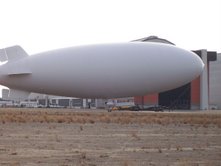My aviation interest became my livelihood in 1998 when I was hired by American Blimp Corporation (ABC) as a junior fabricator. They had just acquired a paint booth and my duty was to help upgrade their FAA-approved paint spec and bring all their painting needs in house.
Within just a couple of months my duties expanded to the composite shop. After training I was solely responsible for all composite fabrication (i.e., airbox, headliner, overhead storage box, fuel cell cover, and floorboards). It was pretty exciting and I was learning so much.
Working for a certified aircraft manufacturer really kept me sharp. There are no shortcuts ever! Everything is precise to the print and everything is tracked documented and certified to the FAA Type Certificate.
During that first year I continued to branch out, learning to make cables and rig controls and building subassemblies and assemblies. One of the senior fabricators knew I was knowledgeable about antique aircraft and he brought me some of his old aviation books. I have always loved the tube and fabric planes and I really enjoy reading histories about them. One of the books, in a section about fabric covering, stated “Although fabric covered aircraft are still being manufactured by several companies, fabric work is a disappearing art. There are only a few independent shops in the United States that would even attempt to take on a fabric job. They realize that it is time consuming, laborious.” (Antique Aircraft, Editors of Flying Magazine.) What I found interesting about that was the book was published in 1979 when I was 8 years old.
I knew that ABC was farming out their fabric work to outside vendors. Both vendors were out of the area and one was over a hundred miles away. I asked them if they would like to bring the covering in house. I was told they always wanted to but couldn’t find any one to take it on.
That was it –I jumped on the opportunity. I studied all the available information on fabric covering and they gave me a shot. They had me cover a set of four rudders for A-60 airship. After that I was given the gig and in 1999 we brought fabric covering in house. For the next 11 years I was solely responsible for all of ABC’s covered components.
There are two models of airships. The A-60 is a 5-passenger airship and the A-170 an 11-passenger airship. Both models have a fabric-covered gondola, four fabric-covered fins with rudders, and a fabric-covered nose dish. I also covered a set of four fins we designed for Lockheed Martin’s (Skunkworks) experimental airship.
Over the course of the 11 years I did covering for ABC I honed my skills and developed my technique.In 2000, I became a senior fabricator and added engine cowling to my job duties, including a prototype for the US Navy airship.

US Navy Blimp
TREVOR LACY
Beaverton, Oregon 97006
(503)841-9496
[email protected]
Trevor, now the owner of Classic Aircraft Restoration with over 20 years experience in the manufacturing and fabrication of blimps and other fabric covered airframes. Adept in performing all detailed fabrication activities related to the construction, restoration and prototyping. He is very knowledgeable in conformance of aviation regulations and codes.
Professional Experience
American Blimp Corporation − Hillsboro, Oregon
Interacted daily with Engineers to review and revise engineering drawings and schematics. Undertake a lead role in fabricating, assembling and testing of finished products (Blimps). Work directly with outside venders and suppliers to ensure quality and timeliness. Directly support field operations including working in the field to troubleshoot or upgrade airships.
Key Highlights
- Detailed fabrication of airship manufactured parts and sub assemblies.
- Manufacturing facility upgrades including equipment identification, procurement, setup, operation and maintenance.
- Lead role in training personnel in all aspects of airship fabrication, assembly and documentation.
- Prototyping and developing new designs, experimental parts, special tooling, fixtures and manufacturing processes.
- Expert in reading and evaluating engineering drawings and schematics.
- Strong composite and fiberglass fabrication skills.
- Expert in aircraft fabric covering and painting.
- Strong sheet metal fabrication skills.
- Quality cabinet making skills.
- Ability to hold extremely tight tolerances and meet all Federal Aviation Administration regulations.